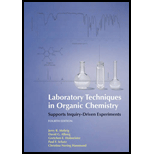
Laboratory Techniques in Organic Chemistry
4th Edition
ISBN: 9781464134227
Author: Jerry R. Mohrig, David Alberg, Gretchen Hofmeister, Paul F. Schatz, Christina Noring Hammond
Publisher: W. H. Freeman
expand_more
expand_more
format_list_bulleted
Question
Chapter 14, Problem 5Q
Interpretation Introduction
Interpretation:
The behavior of the sample that was cooled and then remolded should be explained.
Concept introduction:
The melting point of a crystalline substance is the temperature at which the substance starts changes into the liquid phase. Melting point is directly associated with the presence of intermolecular forces like hydrogen bonding, dipole-dipole interactions. High molecular symmetry, large surface area, polarity is associated with high melting points.
A pure compound melt at a narrow range and compounds with impurities have a wide range of melting points. Melting points are determined by filling the organic compound into the capillary tube with one end sealed.
Expert Solution & Answer
Want to see the full answer?
Check out a sample textbook solution
Students have asked these similar questions
What is the main drawback of using steam distillation in the isolation of volatile oils from its matrix?
Compare simple and fractional distillation for the separation of HEXANE and TOLUENE
What will be the composition of the vapor when a mixture containing 0.30 of A was subjected to fractional distillation with two theoretical plates?
a
0.72 A; 0.28 B
b
0.87 A; 0.13 B
c
0.50 A; 0.50 B
d
0.30 A; 0.70 B
Chapter 14 Solutions
Laboratory Techniques in Organic Chemistry
Knowledge Booster
Similar questions
- What effect does the presence of impurity have on the melting point? Can the amount of impurity be quantified by melting point determination?arrow_forwardA student recrystallized some impure benzoic acid and isolated it by filtration. He scraped the purified benzoic acid off the filter paper after it had dried and took the melting point as a test for purity. He was surprised that most of the white solid melted sharply between 121 and 122 °C but that a small amount remained unmelted even at temperatures above 200 °C. Explain this behavior.arrow_forwardwhy does the observed meltin point change over the course of distillationarrow_forward
- The best liquid mixtures for separation by simple distillation need to have boiling points that differ by at least ___________ oC. 10 20 30 40arrow_forwardFilter paper is usually a poor material on which to powder a solid sample before introducing it into a capillary melting-point tube because small particles of paper may end up in the tube along with the sample. Why is this undesirable? and how might the presence of paper in the sample make the melting-point determination difficultarrow_forwardYou are carrying out an experiment by analysing alcoholic drinks by gas chromatography. Why is Gas chromatography the best technique used for this analysis? Why is Carbowax a suitable stationary phase for this analysis? What gases are used and what is their purpose and source?arrow_forward
- Nitroethylene, HyC = CHNO, is a sensitive compound that must be prepared with great care. Attempted purification of nitroethylene by distillation often results in low recovery of product and a white coating on the inner walls of the distillation apparatus. Explain.arrow_forwardThe melting point (mp) range of reference compound A is 320-340°C. The mp range of a 1:1 mixture of a sample of A with a sample of unknown compound B is found to be 140-300°C. Do the samples consist of identical compounds? A)Yes, because the mp of the mixture is lower than the mp of pure A. B) Not enough information is given to answer the question C) Yes, because they melt over a broad range. D) No, because the mp of the mixture is lower than the melting point of pure A.arrow_forwardWhy the Refractive Index of hexane and heptane from simple distillation closer to the refractive index of hexane and heptane from fractional distillation?arrow_forward
- Compare the simple distillation of pure hexane and binary mixture of hexane and toluene to that of a fractional distillation?arrow_forwardfor the following, should i use fractional or simple distillation?separation of ethylene glycol (Tb = 195 oC) from acetone (Tb = 56 oC)arrow_forwardHow could we verify that two different samples, with the same melting points, are the same compound? Mix melting method. If the two samples are different compounds that happen to have the same melting point, a half and half mixture of the two samples will have a lower and wider melting point range than either sample by itself. If the two samples are the same compound, a half and half mixture of the two samples will have the same melting point as either sample by itself. All of these.arrow_forward
arrow_back_ios
SEE MORE QUESTIONS
arrow_forward_ios
Recommended textbooks for you
 Macroscale and Microscale Organic ExperimentsChemistryISBN:9781305577190Author:Kenneth L. Williamson, Katherine M. MastersPublisher:Brooks Cole
Macroscale and Microscale Organic ExperimentsChemistryISBN:9781305577190Author:Kenneth L. Williamson, Katherine M. MastersPublisher:Brooks Cole EBK A SMALL SCALE APPROACH TO ORGANIC LChemistryISBN:9781305446021Author:LampmanPublisher:CENGAGE LEARNING - CONSIGNMENT
EBK A SMALL SCALE APPROACH TO ORGANIC LChemistryISBN:9781305446021Author:LampmanPublisher:CENGAGE LEARNING - CONSIGNMENT

Macroscale and Microscale Organic Experiments
Chemistry
ISBN:9781305577190
Author:Kenneth L. Williamson, Katherine M. Masters
Publisher:Brooks Cole

EBK A SMALL SCALE APPROACH TO ORGANIC L
Chemistry
ISBN:9781305446021
Author:Lampman
Publisher:CENGAGE LEARNING - CONSIGNMENT